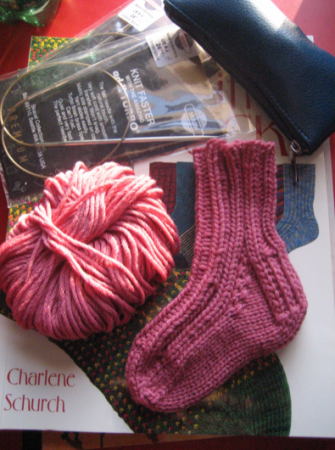To teach, to learn
I had an exciting and fun new experience last week, which is an exceptionally good thing at this point in the winter when so much seems dreary and tired.
I taught a sock knitting class at Woolcott, specifically a class on how to make socks on two circular needles.

Here is my little class sock.
I feel that everyone should know this technique, which is my standard practice. Even if you decide to go back to your DPs or to magic loop it (or to switch between all these methods), it’s worth knowing about the two circular needle method. Good to have options, you know?
I had five students, all very focused and eager to learn. Although not all that eager to be photographed—perhaps some of them are in the Witness Protection Program?—which is why you don’t see them here.
Teaching is as much an art as a skill, I think, and teaching something intellectual (read: abstract) is vastly different than teaching something primarily physical and applied (like knitting). I’ve done way more of the former than the latter, so I have to admit that there are certain challenges, although I like to think that meeting them will make me a better teacher in the long run, no matter what I’m teaching.
For one thing, there are special difficulties in conveying a skill that relies, ultimately, on having a “feel” for how much tension to keep on the yarn. And with socks in particular, on conceptualizing how what you are doing now in the knitting contributes to the architecture of the finished product, on “seeing” in 3-D and allowing that to guide you in your next steps.
It can be hard to find the right words or metaphor to make these things clear. Especially when these are things you have been doing since you were a rather small child. In other words, in some ways, I find it harder to teach something that now feels “natural” to me (even though it isn’t at all) than something I could still viscerally deconstruct into its component parts.
So these are things I try to be mindful of and work on as I teach. Teaching knitting, though, gives me a greater appreciation for what we do as knitters. Because handcrafts are really quite devalued in our culture at this stage in the game, it can be easy to fall into the trap of thinking that this is just some little thing we do, that it is no big deal, that it isn’t special, that anyone could do it.
Which they could. But for most people, it would take a lot of patience and a lot of practice to get really good at it.
So if you’ve gotten really good at it, you should take pride and give yourself some credit.
And if you are just learning, you should give yourself some time and space not to be perfect for a while. In my experience at the shop, adults have a hard time allowing themselves the time to proceed up the learning curve because they are used to having mastery in most of the things they do. They get frustrated learning knitting in a way that kids, who are used to having mastery in almost nothing, don’t.
If I had one piece of advice to give beginning adult knitters, it would be: allow yourself to learn at your own pace, give yourself credit for learning something new, and accept that there will be mistakes and that those are—if I may be a little “Miss Mary Sunshine” for a moment—opportunities for learning.
Eventually, you’ll get really good at knitting, too. And the rewards of that, believe me, will be worth all the difficulties.
February 4th, 2008 at 2:21 pm
Oh, I’m so glad that you’re teaching knitting! It is fun to teach a new skill to people, isn’t it? Especially knitting socks on two circs, which as you know is my preferred method as well. I myself have made many, many pairs of socks using two circulars, and at this point it almost feels like second nature to me as well. But I remember clearly the first pair of socks I made (not that long ago, as it happens) and how very confusing the whole process seemed.
February 5th, 2008 at 12:36 pm
Thanks for your thoughts, Sarah!
February 10th, 2008 at 11:01 am
Hey Ellen! I love that you are teaching a sock knitting class. I wish I were there in Boston to sit in on it with you.
Something that has helped me immensely as an adult learner is the little stair-step diagram about unconscious incompetence, conscious incompetence, conscious competence, and unconscious competence. I’m sure you’re familiar with it. I find it heartening to realize I can move up those learning stairs a little at a time. Thanks for that thought-provoking and encouraging post!
February 13th, 2008 at 2:46 am
I can attest from personal experience that Ellen is the best knitting teacher there ever was! (Hi, by the way!)
April 11th, 2008 at 8:43 pm
I just found your blog and wanted to tell you thanks for putting this together. My aunt taught me how to knit when I was a teen but I always needed her help with it. I kind of gave it up after I had kids but I am going to give it a go again. Your blog has really inspired me! You are so good at this!!!
Patty